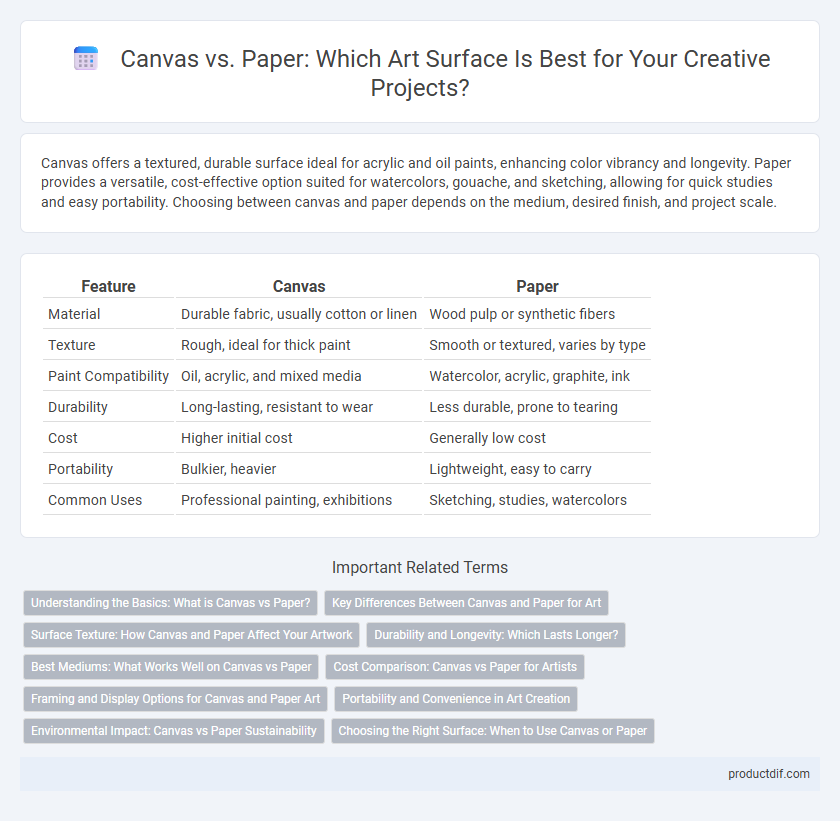Canvas offers a textured, durable surface ideal for acrylic and oil paints, enhancing color vibrancy and longevity. Paper provides a versatile, cost-effective option suited for watercolors, gouache, and sketching, allowing for quick studies and easy portability. Choosing between canvas and paper depends on the medium, desired finish, and project scale.
Table of Comparison
| Feature | Canvas | Paper |
|---|---|---|
| Material | Durable fabric, usually cotton or linen | Wood pulp or synthetic fibers |
| Texture | Rough, ideal for thick paint | Smooth or textured, varies by type |
| Paint Compatibility | Oil, acrylic, and mixed media | Watercolor, acrylic, graphite, ink |
| Durability | Long-lasting, resistant to wear | Less durable, prone to tearing |
| Cost | Higher initial cost | Generally low cost |
| Portability | Bulkier, heavier | Lightweight, easy to carry |
| Common Uses | Professional painting, exhibitions | Sketching, studies, watercolors |
Understanding the Basics: What is Canvas vs Paper?
Canvas is a durable fabric, typically made from cotton or linen, stretched over a wooden frame, offering a textured surface ideal for acrylic and oil paints. Paper, available in various weights and textures, serves as a versatile, portable medium suitable for watercolors, sketches, and mixed media. Understanding the absorbency, texture, and durability differences between canvas and paper helps artists select the best support based on the painting technique and desired longevity.
Key Differences Between Canvas and Paper for Art
Canvas offers a textured, durable surface ideal for oil and acrylic paints, allowing for rich color retention and layered techniques, whereas paper provides a smooth or lightly textured surface suitable for watercolors, pastels, and drawing mediums with quicker absorbency. Canvas typically supports larger formats and is more resistant to moisture and aging, while paper varies widely in weight, texture, and archival quality, often requiring framing for protection. The choice between canvas and paper depends on the artist's medium, desired texture, longevity, and presentation style.
Surface Texture: How Canvas and Paper Affect Your Artwork
Canvas offers a textured surface with visible weave patterns that add depth and dimension to paintings, enhancing techniques like impasto and layering. Paper provides a smooth or slightly textured surface that supports fine detail and precision, ideal for watercolor, ink, and pencil work. The inherent surface texture of canvas and paper directly influences paint absorption, brushstroke expression, and overall artwork finish.
Durability and Longevity: Which Lasts Longer?
Canvas offers superior durability and longevity compared to paper, as it resists tearing, warping, and environmental damage more effectively. High-quality canvas, especially linen, can endure centuries without significant degradation, making it ideal for professional and archival artworks. Paper tends to be more vulnerable to moisture, light exposure, and acidity, which accelerate aging and reduce its lifespan.
Best Mediums: What Works Well on Canvas vs Paper
Canvas excels with oil and acrylic paints due to its durability and textured surface that enhances pigment adherence and blending. Paper is ideal for watercolors, graphite, and ink, providing a smooth finish that allows delicate strokes and washes to stand out sharply. Each medium complements the material's unique absorbency and texture, influencing color vibrancy and detail precision.
Cost Comparison: Canvas vs Paper for Artists
Canvas generally costs more than paper due to its durability and texture, making it a preferred choice for long-lasting artworks. High-quality canvas can range from $10 to $50 per sheet or roll, while artist-grade paper typically costs between $5 and $20 per pad or sheet. For budget-conscious artists, paper offers a more affordable option without sacrificing quality for studies or practice pieces.
Framing and Display Options for Canvas and Paper Art
Canvas artwork offers versatile framing options including traditional wood frames with or without glass, allowing for a polished or contemporary look while maintaining texture visibility. Paper art typically requires glass framing to protect from environmental damage, often utilizing matting to enhance the presentation and prevent direct contact with the glass. Both mediums support various display choices, but canvas is favored for gallery-style unframed displays due to its durability and depth.
Portability and Convenience in Art Creation
Canvas offers durability and a stable surface ideal for long-term projects but tends to be bulkier and less portable than paper. Paper is lightweight, flexible, and easy to transport, making it the preferred choice for artists who prioritize convenience and spontaneous creation. The choice between canvas and paper depends on the artist's need for mobility versus the desired texture and longevity of their artwork.
Environmental Impact: Canvas vs Paper Sustainability
Canvas made from organic cotton or hemp offers greater durability and reusability, reducing waste over time compared to paper products, which typically use trees and are less biodegradable due to chemical coatings. Paper production involves high water consumption and energy use, contributing significantly to deforestation and carbon emissions, whereas sustainably sourced canvas materials often have a smaller ecological footprint when managed responsibly. Choosing recycled or eco-certified paper can mitigate some environmental issues, but the longevity and reuse potential of canvas ultimately support a more sustainable art practice.
Choosing the Right Surface: When to Use Canvas or Paper
Canvas offers superior durability and texture ideal for oil and acrylic paintings that require layering and blending, while paper provides a smoother, more affordable surface suited for watercolors, inks, and sketching. Artists should choose canvas for works demanding longevity and vivid color retention, whereas paper is preferable for practice, studies, or media that absorb more easily. Understanding the medium's interaction with the surface ensures optimal texture, color vibrancy, and preservation of the artwork.
Canvas vs Paper Infographic

 productdif.com
productdif.com